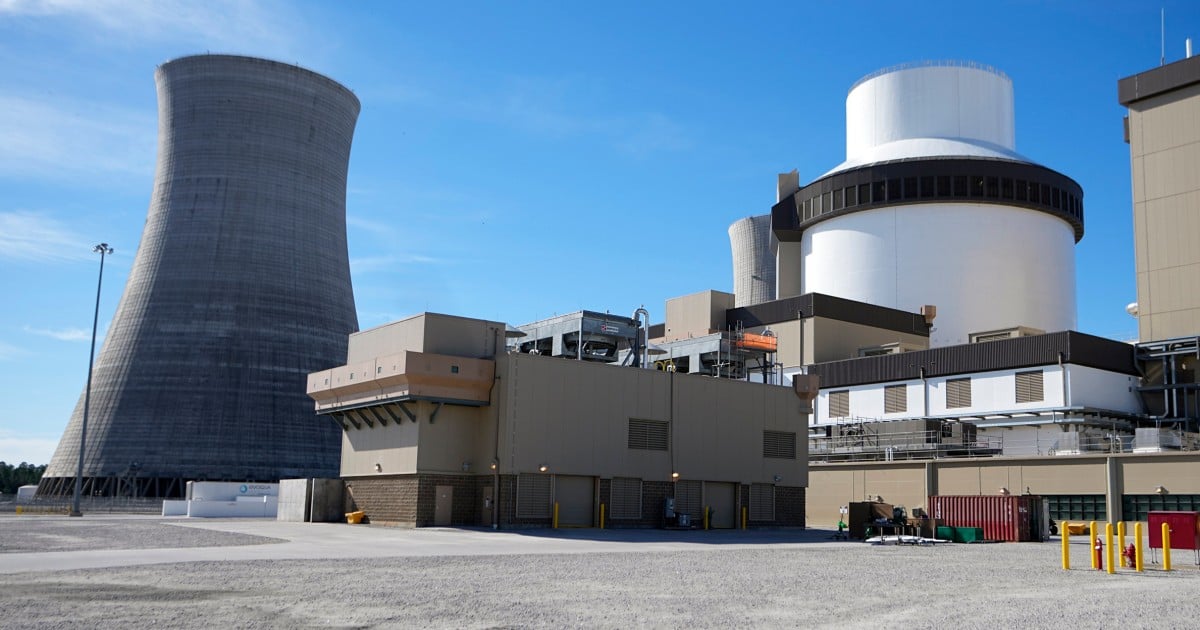First U.S. nuclear reactor built from scratch in decades enters commercial operation in Georgia::ATLANTA — A new reactor at a nuclear power plant in Georgia has entered commercial operation, becoming the first new American reactor built from scratch in decades.
Ooh a lot of people here seem very pro-nuclear-power. That’s cool!
14 years and 35 billion (combined with #4 which has not been finished) and didn’t generate a single kWh in anger until now. Put the same investment into renewables and it would generate similar or greater energy and would start doing so within a year.
The argument against nuclear now is not about safety. It is about money. Nuclear simply cannot compete without massive subsidies.
Oh, neat. My state did something not completely stupid. I’ve got some reservations about nuke power as opposed to renewable, but this is definitely better than continuing fossil fuels.
Fission and fusion reactors are really more like in-between renewable and non-renewable. Sure, it relies on materials that are finite, but there is way, way more of that material available in comparison to how much we need.
Making this distinction is necessary to un-spook people who have gone along with the panic induced by bad media and lazy engineering of the past.
redacted
I’m spooked by the fact that you have no idea how the US enriches uranium, or the difference between a power pressurized water reactor and a fast “breeder” reactor (if you were thinking of plutonium) or a centrifuge.
The US enriches uranium using a gas-centrifuge. The US also no longer recycles spent nuclear fuel, but France does.
redacted
Good news. Anything but fossil fuels at this point.
The reduced operating emissions take 10+ years to outweigh the enormous construction emissions of nuclear. (Compared to gas.)
Fortunately the nuclear reactor can be operated for >50 years :)
Oh wow really? Hope it kicks off some good news for other plants in the future.
The good news - it’s online, generating clean power, and hopefully demonstrating the safety and benefits of modern nuclear plants.
The bad news - it’s $17B over budget (+120%) and 7 years behind schedule (+100%). Those kind of overages aren’t super promising for investors, but perhaps there are enough lessons learned on this one that will help the next one sail a little smoother.
Either way, good to see it can still be done in the US.
Let it run 5 months and the money is back in.
Not really. All costs considered, nuclear is one of the most expensive energy sources.
Yes nuclear power plants are very expensive. But the energy density is phenomenal.
Energetic armortisation is far quicker on a nuclear plant than on solar panels.
And the argument of subsidies is usually a fake one, since governments also pour millions into renewable energies.
Broken down to lifetime cost to the cost of comparable technologies, nuclear is still on the same level as solar and wind.
Since I am from Germany, and German sources might not be ideal to share, let me explain it this way: People are not stupid. They will never choose the financially unwise option, if the other one would seriously be the better one.
People do often act stupid, but you are seeing it from what I consider to be an incomplete perspective. Nuclear could be financially unwise overall, but someone would still get a payday. That 17B over budget wasn’t burned and unmade, it went into the pockets of the people organizing and building the power plant.
All this to say, the huge majority of the people involved in making the power plant a reality weren’t motivated by the efficiency of the power production on a cost basis. Most of them were probably making more money while it was still being subsidized, planned, and built. And while I think subsidies are generally useful and good, they can be a vector of financial abuse when it comes to unprofitable industries.
Lastly “lifetime cost” is a bit of a useless metric when the majority of that lifetime comes too late. No point to a power source that will cleanly produce power after it has meaningfully contributed to pushing us over the edge and past the breaking point for a climate that can support agriculture as we know it. There isn’t enough time or margin for error in emissions left available to build all the nuclear plants needed to meet energy demands.
Can you find any recent analysis that supports your claim that nuclear costs are at the same level as solar?
The only one I’ve seen suggest this was from a nuclear industry lobby group, and it inflated the costs or solar by insane amounts.
In Australia this is a bit of a hot topic and all impartial estimates suggest that nuclear will not get close to renewables in any way, even taking into account storage and grid costs.
In the 10 years since this single reactor was built, one of our states has transitioned to almost 100% renewables. Wholesale costs have plummeted, but renewable projects are still profitable in the market. I was involved in a reactor project in a western nation some time ago (it’s still being completed unsurprisingly), and the lock-in wholesale price to support that project was simply extortionate. Solar generation prices are a whole magnitude smaller.
This is a German source that incorporates many studies and presents their results. Some agree with my statement, some with yours. But fact is, that the financial difference is very small.
Page 23 for example suggests my statement.
On page 32 you can see the development that suggests that you are right.
But considering the costs for the expansion of the energy grid, battery storage systems, and the rising production costs of everything, I believe Nuclear to be the cheaper option and the far more reliable one.
The nameplate cost of this plant is $32 per watt. Even at smaller scales, utility-scale solar plants are $1 per watt. Do you know how many grid storage batteries you could buy with the extra $31 per watt? (6 hour storage is around $2.50 per watt or $.40/Wh.) You could build a solar plant 4x the nameplate capacity of the nuke (in order to match the capacity factor), and add 24 hours of storage to make it fully dispatchable, and still have enough money left over to build 2 more of the same thing. This doesn’t even include the fact the nuclear has fuel costs, waste disposal, higher continued operational costs, and unaccounted publicly involuntarily subsidized disaster insurance.
Let’s play around with the thought of powering all of America with renewables. America’s coal, gas, petroleum and nuclear plants generate a combined baseload power of 405 GWavg, or “gigawatts average.” (Remember, a gigawatt is a thousand megawatts.) Let’s replace all of them with a 50 / 50 mix of onshore wind and CSP (solar), and since our energy needs are constantly growing, let’s round up the total to 500 GWs, which is likely what we’ll need by the time we finish. Some folks say that we should level off or reduce our consumption by conserving and using more efficient devices, which is true in principle. But in practice, human nature is such that whatever energy we save, we just gobble up with more gadgets. So we’d better figure on 500 GWs.
To generate this much energy with 1,000 of our 500 MW renewables farms, we’ll put 500 wind farms in the Midwest (and hope the wind patterns don’t change…) and we’ll put 500 CSP farms in the southwest deserts—all of it on free federal land and hooked into the grid. Aside from whatever branch transmission lines we’ll need (which will be chump change), here’s the lowdown:
Powering the U.S. with 500 wind and 500 CSP farms, at 500 MWavg apiece.
Steel ……………….. 503 Million tonnes (5.6 times annual U.S. production) Concrete ………….. 1.57 Billion t (3.2 times annual U.S. production) CO2 …………………. 3.3 Billion t (all U.S. passenger cars for 2.5 years) Land ………………… 91,000 km2 (302 km / side)35,135 sq. miles (169 mi / side)
(the size of Indiana)
60-year cost ……… $29.25 Trillion
That’s 29 times the 2014 discretionary federal budget.
If we can convince the wind lobby that they’re outclassed by CSP, we could do the entire project for a lot less, and put the whole enchilada in the desert:
Powering the U.S. with 1,000 CSP farms, producing 500 MWavg apiece.
Steel ………………. 787 Million t (1.6 times annual U.S. production) Concrete …………. 2.52 Billion t (5.14 times annual U.S. production) CO2 ………………… 3.02 Billion t (all U.S. passenger cars for 2.3 years) Land ……………….. 63,000 km2 (251 km / side)24,234 sq. miles (105.8 mi / side)
(the size of West Virginia)
60-year cost ……. $18.45 Trillion
#That’s to 18 times the 2014 federal budget.
Or, we could power the U.S. with 500 AP-1000 reactors.
Rated at 1,117 MWp, and with a reactor’s typical uptime of 90%, an AP-1000 will deliver 1,005 MWav. Five hundred APs will produce 502.5 GWav, replacing all existing U.S. electrical power plants, including our aging fleet of reactors.
The AP-1000 uses 5,800 tonnes of steel, 90,000 tonnes of concrete, with a combined carbon karma of 115,000 t of CO2 that can be paid down in less than 5 days. The entire plant requires 0.04km2, a patch of land just 200 meters on a side, next to an ample body of water for cooling. (Remember, it’s a Gen-3+ reactor. Most Gen-4 reactors won’t need external cooling.) Here’s the digits:
Steel ………. 2.9 Million t (0.5% of W & CSP / 0.36% of CSP) Concrete … 46.5 Million t (3.3% of W & CSP / 1.8% of CSP) CO2 ……….. 59.8 Million tonnes (2% of W & CSP / 1.5% of CSP) Land ………. 20.8 km2 (4.56 km / side) (0.028% W & CSP / 0.07% of CSP)1.95 sq. miles (1.39 miles / side)
(1.5 times the size of Central Park)
60-year cost ……… $2.94 Trillion
#That’s 2.9 times the 2014 federal budget.
Small Modular Reactors may cost a quarter or half again as much, but the buy-in is significantly less, the build-out is much faster (picture jetliners rolling off the assembly line), the resources and CO2 are just as minuscule, and they can be more widely distributed, ensuring the resiliency of the grid with multiple nodes.
And this is without even mentioning MSRs.
Was this project a complete shitshow of sheldon before seen-proportions?
Yes.
Does this mean that we should make the move towards powering the US from 100% renewables instead?
Well if you hate math and logic enough to even consider it, sure. Go ahead.
Uh.
The nuke plant is expensive. Renewables aren’t. And your argument ist essentially “but based on made up numbers that illustrate how inexpensive nuke plants could be, nuke plants could be much less expensive! Duh!”
Yeah, no. Build renewables.
I’m not quite why the argument is “nuclear or renewables.” It should be nuclear AND renewables.
Renewable energy generators have improved significantly in the last two decades. I’m sure they will continue to improve.
Nuclear power is a hell of a lot cleaner than coal. And it seems nuclear power plants have improved tremendously. We should use them.
Ah, i remember studying the Westinghouse AP1000 reactor design when I was at Uni. It had just been approved, and numerous plants were expected, with the first expected to be online from around 2010.
It’s 2023, and this is the first one to go live in the US.










